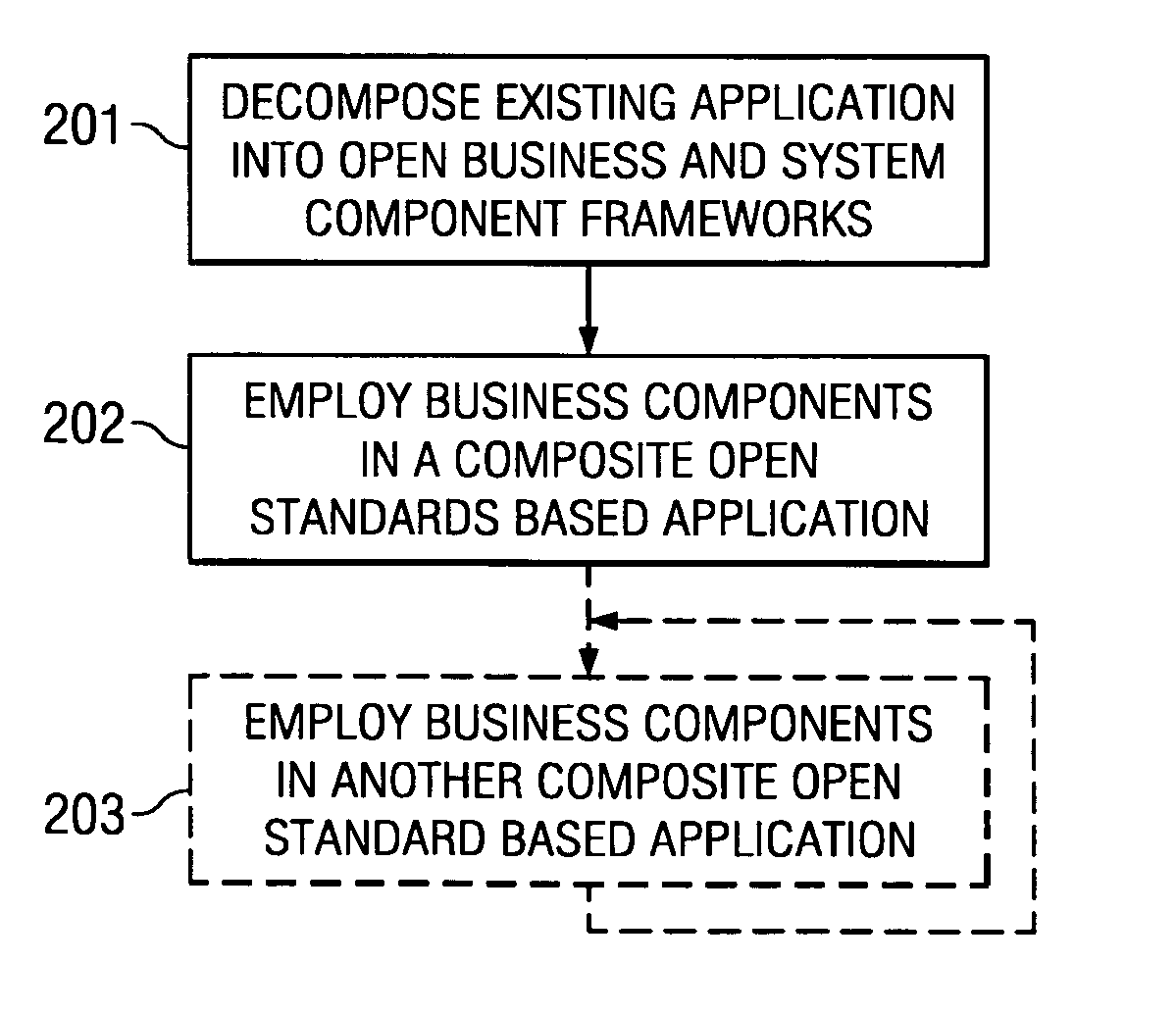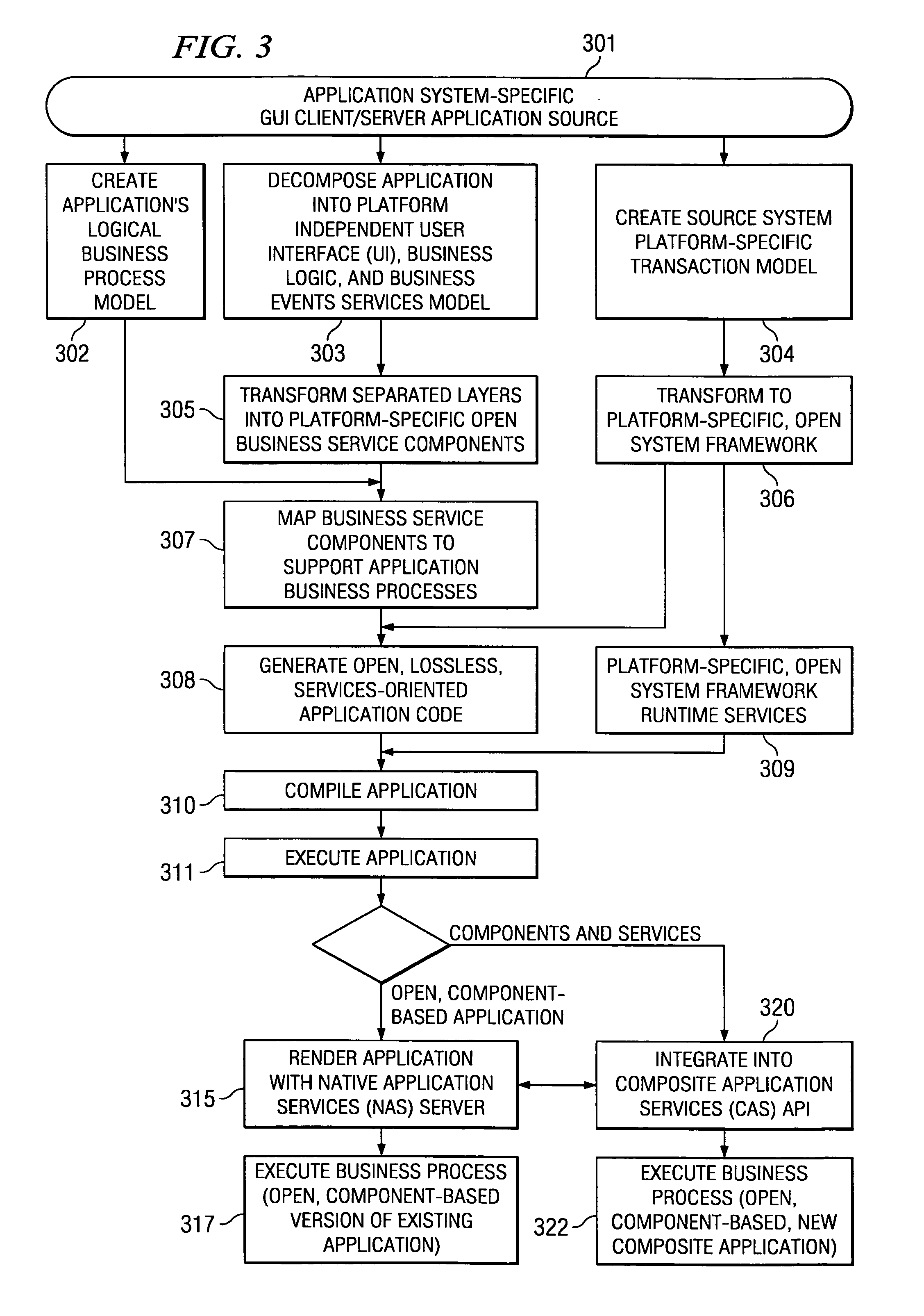Systems and methods for modeling and generating reusable application component frameworks, and automated assembly of service-oriented applications from existing applications
a technology of application component framework and system implementation, which is applied in the direction of source code generation, computing, electric digital data processing, etc., can solve the problems of blind re-engineering of enterprise applications, inability to fully automate software-based solutions to bridge legacy client/server application technology with the new-generation, open standards-based platform, and inability to blindly re-engineer enterprise applications. , to achieve the effect of avoiding the restraints of proprietary technology platform, reducing
- Summary
- Abstract
- Description
- Claims
- Application Information
AI Technical Summary
Benefits of technology
Problems solved by technology
Method used
Image
Examples
embodiment 100
[0027]FIG. 1 is a flowchart of embodiment 100 of decomposition of an existing source application and creation of an open standards-based version of the existing application in accordance with the present methods. At 101 an existing application, is decomposed into one or more open standards-based business components which may be distributed in one or more frameworks. The existing application may be monolithic, for example a graphical user interface-implemented client / server application, or the like. The frameworks may include a business service component framework and / or a system service component framework, which in turn may include a presentation or user interface, business logic, and / or event management capabilities. At 102 the components are reassembled into an open standards-based application for service oriented architectures, utilizing the framework(s) and rendering a similar appearance and behavior for the open-standards-based application as provided by the existing applicati...
embodiment 200
[0028]FIG. 2 is a flowchart of embodiment 200 for decomposition of an existing source application and creation of open standards-based business components in accordance with the present methods. At 201 an existing application is also decomposed into one or more open standards-based business components in one or more frameworks. Here too, the existing application may be a graphical user interface-implemented client / server application and the separate layers may be a user interface, business logic, and / or event management layers. Also, the frameworks in this case may include at least a business service component framework and a system service component framework At 202 the business components are employed in an external service oriented architecture application, or the like, at a desired level of granularity, such as according to the external composite application's business process support requirements. The business components may be reused in other external service oriented architec...
embodiment 300
[0029]FIG. 3 is a flowchart of embodiment 300 for decomposition of an existing source application and creation of open standards-based business components in accordance with the present methods. At 301 and existing application source, such as a GUI-implemented client / server application. Concurrently at 302, 303 and 304, a set of logical models of the source application may be created (302); the application may be decomposed into a platform-independent Model View Controller (MVC) architecture. (303); and a source system platform specific transaction model may be created (304). As created at 303, the MVC View may contain a presentation of a UI; the MVC Model may contain domain and business logic pertaining to business processes supported by the source application; and / or the MVC Controller may manage events for the transaction state of business process implementation. At 305 the source application logical models may be transformed into platform-specific open standard-based business se...
PUM
 Login to View More
Login to View More Abstract
Description
Claims
Application Information
 Login to View More
Login to View More - R&D
- Intellectual Property
- Life Sciences
- Materials
- Tech Scout
- Unparalleled Data Quality
- Higher Quality Content
- 60% Fewer Hallucinations
Browse by: Latest US Patents, China's latest patents, Technical Efficacy Thesaurus, Application Domain, Technology Topic, Popular Technical Reports.
© 2025 PatSnap. All rights reserved.Legal|Privacy policy|Modern Slavery Act Transparency Statement|Sitemap|About US| Contact US: help@patsnap.com



